Macro Analysis of Woolworths Group: A Business Report
VerifiedAdded on 2022/11/14
|9
|2287
|365
Report
AI Summary
This report provides a comprehensive macro-environmental analysis of the Woolworths Group, a major player in the Australian retail market. The analysis utilizes Porter's Five Forces to evaluate the competitive landscape, including the bargaining power of buyers and suppliers, threats of new entrants and substitutes, and rivalry among existing firms. The report delves into the impact of various macro-environmental factors, such as political, economic, social, technological, legal, and environmental influences on Woolworths' operations and profitability. Political factors, including government policies and regulations, are examined for their potential impact on the company's market share. Technological advancements, such as green refrigeration and self-checkout systems, are highlighted for their role in improving operational efficiency. Economic factors, including consumer purchasing power, inflation, and interest rates, are assessed for their impact on sales and consumer behavior. Social factors, such as demographic trends and consumer preferences, are also considered. Finally, the report considers the environmental and legal factors that affect Woolworths' operations, including environmental standards, intellectual property rights, and consumer protection laws. The report concludes by highlighting the challenges and opportunities facing Woolworths in the evolving Australian retail market.
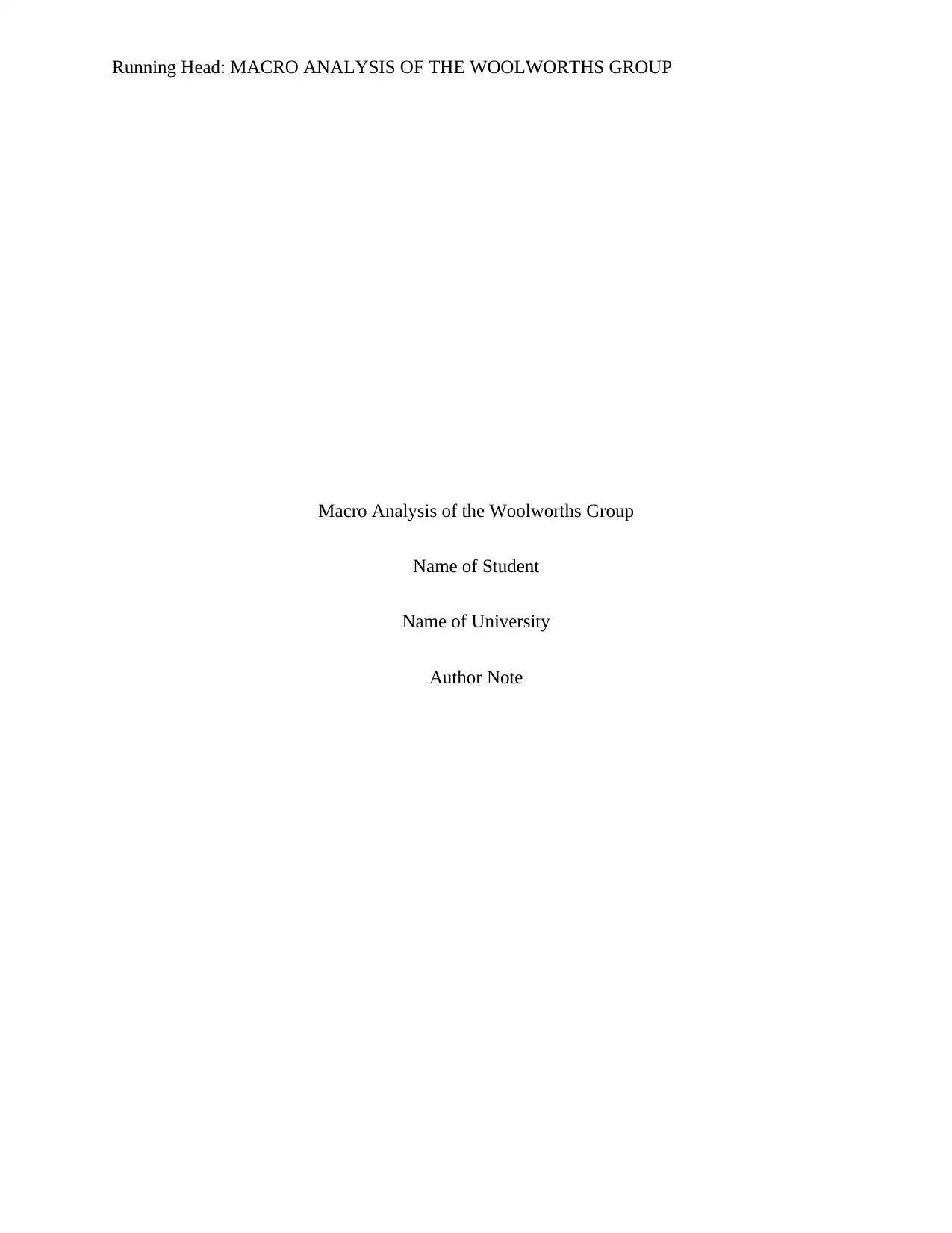
Running Head: MACRO ANALYSIS OF THE WOOLWORTHS GROUP
Macro Analysis of the Woolworths Group
Name of Student
Name of University
Author Note
Macro Analysis of the Woolworths Group
Name of Student
Name of University
Author Note
Paraphrase This Document
Need a fresh take? Get an instant paraphrase of this document with our AI Paraphraser
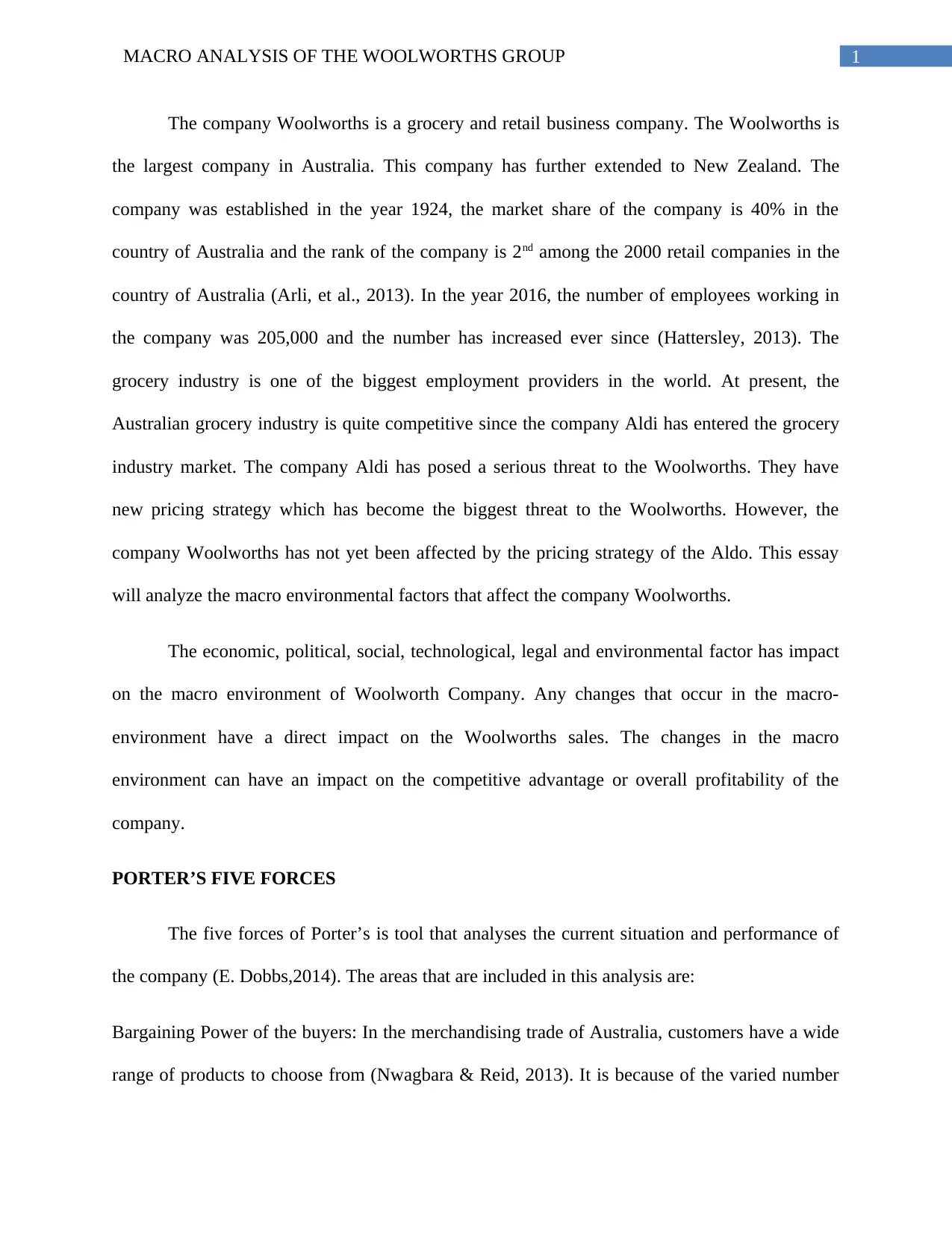
1MACRO ANALYSIS OF THE WOOLWORTHS GROUP
The company Woolworths is a grocery and retail business company. The Woolworths is
the largest company in Australia. This company has further extended to New Zealand. The
company was established in the year 1924, the market share of the company is 40% in the
country of Australia and the rank of the company is 2nd among the 2000 retail companies in the
country of Australia (Arli, et al., 2013). In the year 2016, the number of employees working in
the company was 205,000 and the number has increased ever since (Hattersley, 2013). The
grocery industry is one of the biggest employment providers in the world. At present, the
Australian grocery industry is quite competitive since the company Aldi has entered the grocery
industry market. The company Aldi has posed a serious threat to the Woolworths. They have
new pricing strategy which has become the biggest threat to the Woolworths. However, the
company Woolworths has not yet been affected by the pricing strategy of the Aldo. This essay
will analyze the macro environmental factors that affect the company Woolworths.
The economic, political, social, technological, legal and environmental factor has impact
on the macro environment of Woolworth Company. Any changes that occur in the macro-
environment have a direct impact on the Woolworths sales. The changes in the macro
environment can have an impact on the competitive advantage or overall profitability of the
company.
PORTER’S FIVE FORCES
The five forces of Porter’s is tool that analyses the current situation and performance of
the company (E. Dobbs,2014). The areas that are included in this analysis are:
Bargaining Power of the buyers: In the merchandising trade of Australia, customers have a wide
range of products to choose from (Nwagbara & Reid, 2013). It is because of the varied number
The company Woolworths is a grocery and retail business company. The Woolworths is
the largest company in Australia. This company has further extended to New Zealand. The
company was established in the year 1924, the market share of the company is 40% in the
country of Australia and the rank of the company is 2nd among the 2000 retail companies in the
country of Australia (Arli, et al., 2013). In the year 2016, the number of employees working in
the company was 205,000 and the number has increased ever since (Hattersley, 2013). The
grocery industry is one of the biggest employment providers in the world. At present, the
Australian grocery industry is quite competitive since the company Aldi has entered the grocery
industry market. The company Aldi has posed a serious threat to the Woolworths. They have
new pricing strategy which has become the biggest threat to the Woolworths. However, the
company Woolworths has not yet been affected by the pricing strategy of the Aldo. This essay
will analyze the macro environmental factors that affect the company Woolworths.
The economic, political, social, technological, legal and environmental factor has impact
on the macro environment of Woolworth Company. Any changes that occur in the macro-
environment have a direct impact on the Woolworths sales. The changes in the macro
environment can have an impact on the competitive advantage or overall profitability of the
company.
PORTER’S FIVE FORCES
The five forces of Porter’s is tool that analyses the current situation and performance of
the company (E. Dobbs,2014). The areas that are included in this analysis are:
Bargaining Power of the buyers: In the merchandising trade of Australia, customers have a wide
range of products to choose from (Nwagbara & Reid, 2013). It is because of the varied number
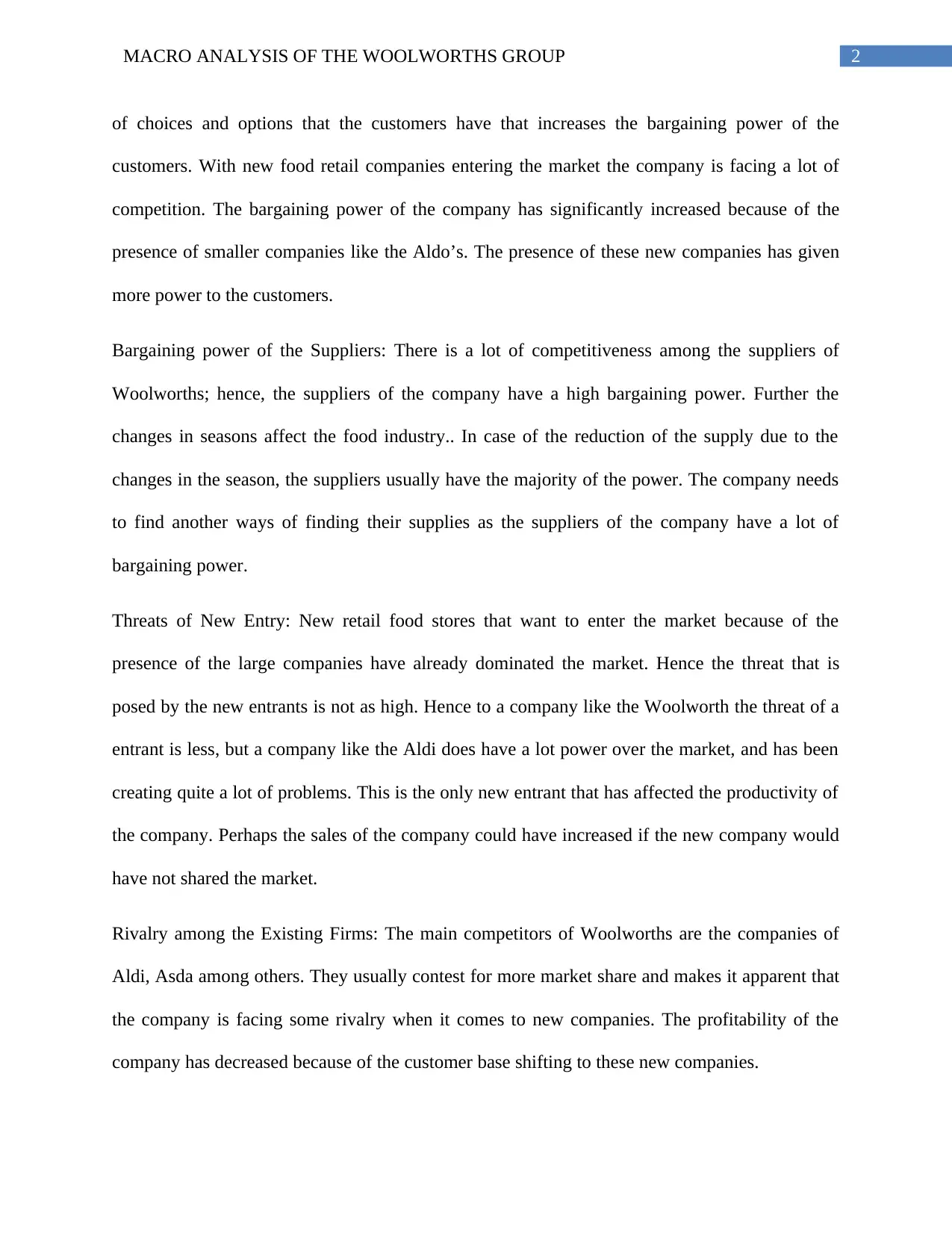
2MACRO ANALYSIS OF THE WOOLWORTHS GROUP
of choices and options that the customers have that increases the bargaining power of the
customers. With new food retail companies entering the market the company is facing a lot of
competition. The bargaining power of the company has significantly increased because of the
presence of smaller companies like the Aldo’s. The presence of these new companies has given
more power to the customers.
Bargaining power of the Suppliers: There is a lot of competitiveness among the suppliers of
Woolworths; hence, the suppliers of the company have a high bargaining power. Further the
changes in seasons affect the food industry.. In case of the reduction of the supply due to the
changes in the season, the suppliers usually have the majority of the power. The company needs
to find another ways of finding their supplies as the suppliers of the company have a lot of
bargaining power.
Threats of New Entry: New retail food stores that want to enter the market because of the
presence of the large companies have already dominated the market. Hence the threat that is
posed by the new entrants is not as high. Hence to a company like the Woolworth the threat of a
entrant is less, but a company like the Aldi does have a lot power over the market, and has been
creating quite a lot of problems. This is the only new entrant that has affected the productivity of
the company. Perhaps the sales of the company could have increased if the new company would
have not shared the market.
Rivalry among the Existing Firms: The main competitors of Woolworths are the companies of
Aldi, Asda among others. They usually contest for more market share and makes it apparent that
the company is facing some rivalry when it comes to new companies. The profitability of the
company has decreased because of the customer base shifting to these new companies.
of choices and options that the customers have that increases the bargaining power of the
customers. With new food retail companies entering the market the company is facing a lot of
competition. The bargaining power of the company has significantly increased because of the
presence of smaller companies like the Aldo’s. The presence of these new companies has given
more power to the customers.
Bargaining power of the Suppliers: There is a lot of competitiveness among the suppliers of
Woolworths; hence, the suppliers of the company have a high bargaining power. Further the
changes in seasons affect the food industry.. In case of the reduction of the supply due to the
changes in the season, the suppliers usually have the majority of the power. The company needs
to find another ways of finding their supplies as the suppliers of the company have a lot of
bargaining power.
Threats of New Entry: New retail food stores that want to enter the market because of the
presence of the large companies have already dominated the market. Hence the threat that is
posed by the new entrants is not as high. Hence to a company like the Woolworth the threat of a
entrant is less, but a company like the Aldi does have a lot power over the market, and has been
creating quite a lot of problems. This is the only new entrant that has affected the productivity of
the company. Perhaps the sales of the company could have increased if the new company would
have not shared the market.
Rivalry among the Existing Firms: The main competitors of Woolworths are the companies of
Aldi, Asda among others. They usually contest for more market share and makes it apparent that
the company is facing some rivalry when it comes to new companies. The profitability of the
company has decreased because of the customer base shifting to these new companies.
⊘ This is a preview!⊘
Do you want full access?
Subscribe today to unlock all pages.

Trusted by 1+ million students worldwide
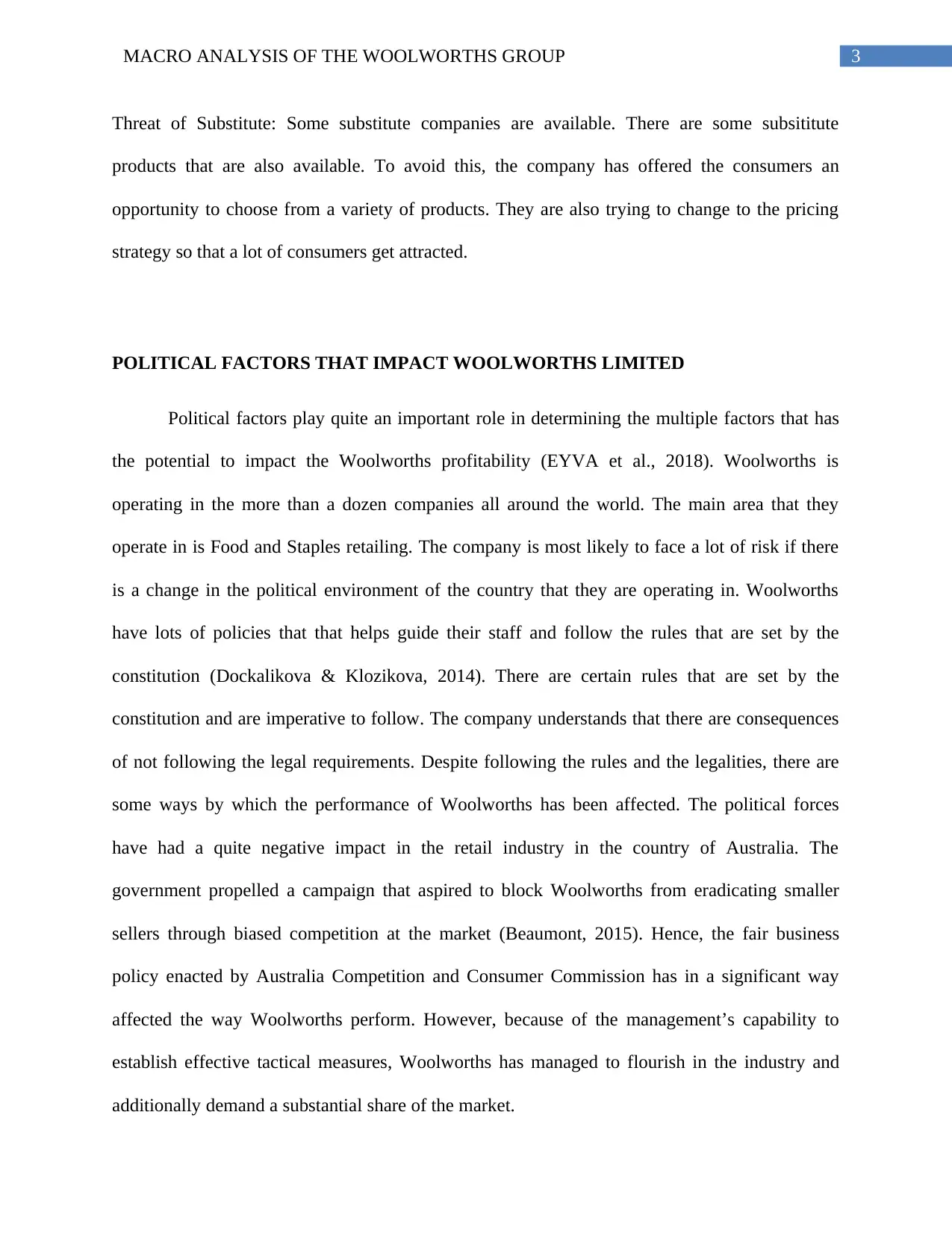
3MACRO ANALYSIS OF THE WOOLWORTHS GROUP
Threat of Substitute: Some substitute companies are available. There are some subsititute
products that are also available. To avoid this, the company has offered the consumers an
opportunity to choose from a variety of products. They are also trying to change to the pricing
strategy so that a lot of consumers get attracted.
POLITICAL FACTORS THAT IMPACT WOOLWORTHS LIMITED
Political factors play quite an important role in determining the multiple factors that has
the potential to impact the Woolworths profitability (EYVA et al., 2018). Woolworths is
operating in the more than a dozen companies all around the world. The main area that they
operate in is Food and Staples retailing. The company is most likely to face a lot of risk if there
is a change in the political environment of the country that they are operating in. Woolworths
have lots of policies that that helps guide their staff and follow the rules that are set by the
constitution (Dockalikova & Klozikova, 2014). There are certain rules that are set by the
constitution and are imperative to follow. The company understands that there are consequences
of not following the legal requirements. Despite following the rules and the legalities, there are
some ways by which the performance of Woolworths has been affected. The political forces
have had a quite negative impact in the retail industry in the country of Australia. The
government propelled a campaign that aspired to block Woolworths from eradicating smaller
sellers through biased competition at the market (Beaumont, 2015). Hence, the fair business
policy enacted by Australia Competition and Consumer Commission has in a significant way
affected the way Woolworths perform. However, because of the management’s capability to
establish effective tactical measures, Woolworths has managed to flourish in the industry and
additionally demand a substantial share of the market.
Threat of Substitute: Some substitute companies are available. There are some subsititute
products that are also available. To avoid this, the company has offered the consumers an
opportunity to choose from a variety of products. They are also trying to change to the pricing
strategy so that a lot of consumers get attracted.
POLITICAL FACTORS THAT IMPACT WOOLWORTHS LIMITED
Political factors play quite an important role in determining the multiple factors that has
the potential to impact the Woolworths profitability (EYVA et al., 2018). Woolworths is
operating in the more than a dozen companies all around the world. The main area that they
operate in is Food and Staples retailing. The company is most likely to face a lot of risk if there
is a change in the political environment of the country that they are operating in. Woolworths
have lots of policies that that helps guide their staff and follow the rules that are set by the
constitution (Dockalikova & Klozikova, 2014). There are certain rules that are set by the
constitution and are imperative to follow. The company understands that there are consequences
of not following the legal requirements. Despite following the rules and the legalities, there are
some ways by which the performance of Woolworths has been affected. The political forces
have had a quite negative impact in the retail industry in the country of Australia. The
government propelled a campaign that aspired to block Woolworths from eradicating smaller
sellers through biased competition at the market (Beaumont, 2015). Hence, the fair business
policy enacted by Australia Competition and Consumer Commission has in a significant way
affected the way Woolworths perform. However, because of the management’s capability to
establish effective tactical measures, Woolworths has managed to flourish in the industry and
additionally demand a substantial share of the market.
Paraphrase This Document
Need a fresh take? Get an instant paraphrase of this document with our AI Paraphraser
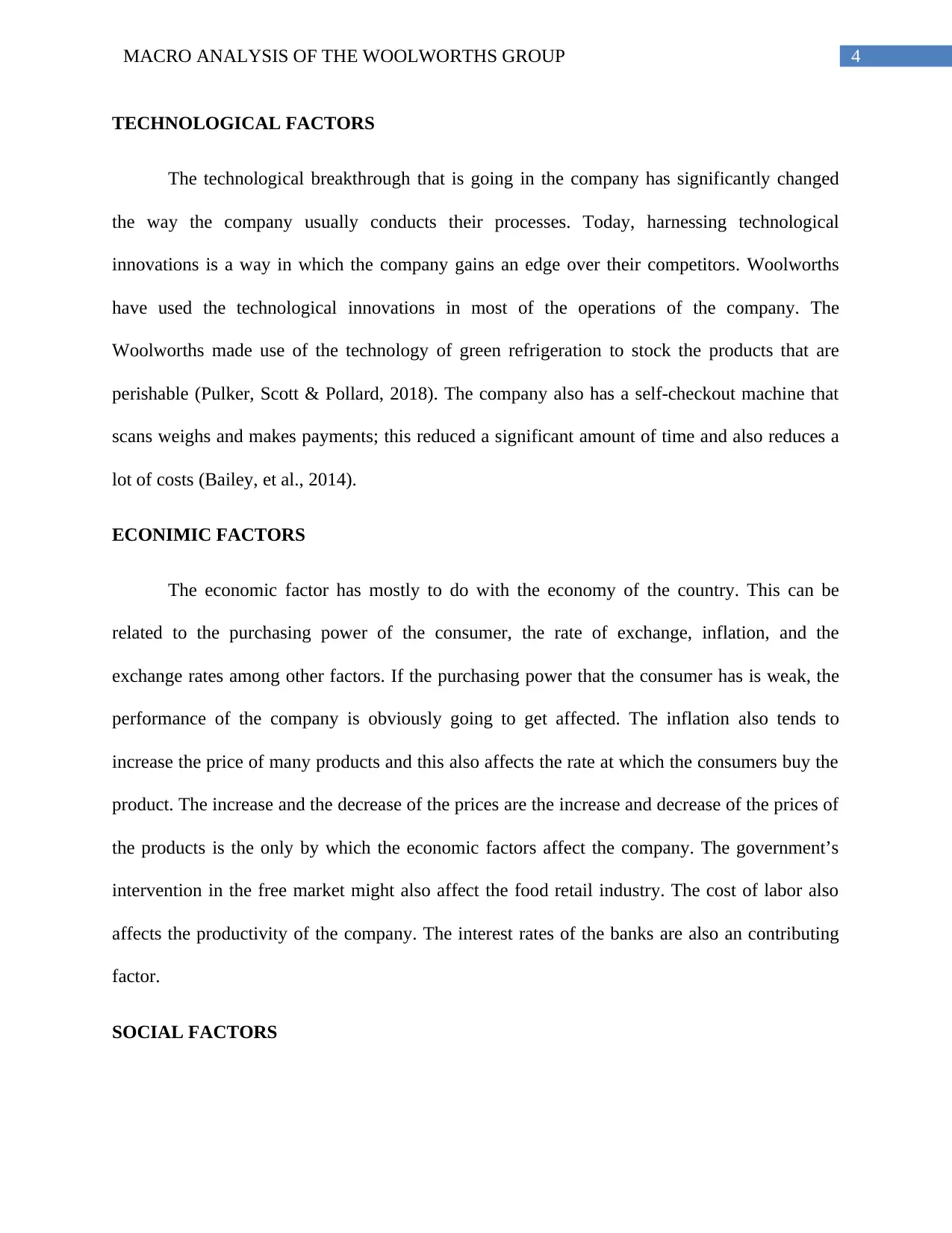
4MACRO ANALYSIS OF THE WOOLWORTHS GROUP
TECHNOLOGICAL FACTORS
The technological breakthrough that is going in the company has significantly changed
the way the company usually conducts their processes. Today, harnessing technological
innovations is a way in which the company gains an edge over their competitors. Woolworths
have used the technological innovations in most of the operations of the company. The
Woolworths made use of the technology of green refrigeration to stock the products that are
perishable (Pulker, Scott & Pollard, 2018). The company also has a self-checkout machine that
scans weighs and makes payments; this reduced a significant amount of time and also reduces a
lot of costs (Bailey, et al., 2014).
ECONIMIC FACTORS
The economic factor has mostly to do with the economy of the country. This can be
related to the purchasing power of the consumer, the rate of exchange, inflation, and the
exchange rates among other factors. If the purchasing power that the consumer has is weak, the
performance of the company is obviously going to get affected. The inflation also tends to
increase the price of many products and this also affects the rate at which the consumers buy the
product. The increase and the decrease of the prices are the increase and decrease of the prices of
the products is the only by which the economic factors affect the company. The government’s
intervention in the free market might also affect the food retail industry. The cost of labor also
affects the productivity of the company. The interest rates of the banks are also an contributing
factor.
SOCIAL FACTORS
TECHNOLOGICAL FACTORS
The technological breakthrough that is going in the company has significantly changed
the way the company usually conducts their processes. Today, harnessing technological
innovations is a way in which the company gains an edge over their competitors. Woolworths
have used the technological innovations in most of the operations of the company. The
Woolworths made use of the technology of green refrigeration to stock the products that are
perishable (Pulker, Scott & Pollard, 2018). The company also has a self-checkout machine that
scans weighs and makes payments; this reduced a significant amount of time and also reduces a
lot of costs (Bailey, et al., 2014).
ECONIMIC FACTORS
The economic factor has mostly to do with the economy of the country. This can be
related to the purchasing power of the consumer, the rate of exchange, inflation, and the
exchange rates among other factors. If the purchasing power that the consumer has is weak, the
performance of the company is obviously going to get affected. The inflation also tends to
increase the price of many products and this also affects the rate at which the consumers buy the
product. The increase and the decrease of the prices are the increase and decrease of the prices of
the products is the only by which the economic factors affect the company. The government’s
intervention in the free market might also affect the food retail industry. The cost of labor also
affects the productivity of the company. The interest rates of the banks are also an contributing
factor.
SOCIAL FACTORS
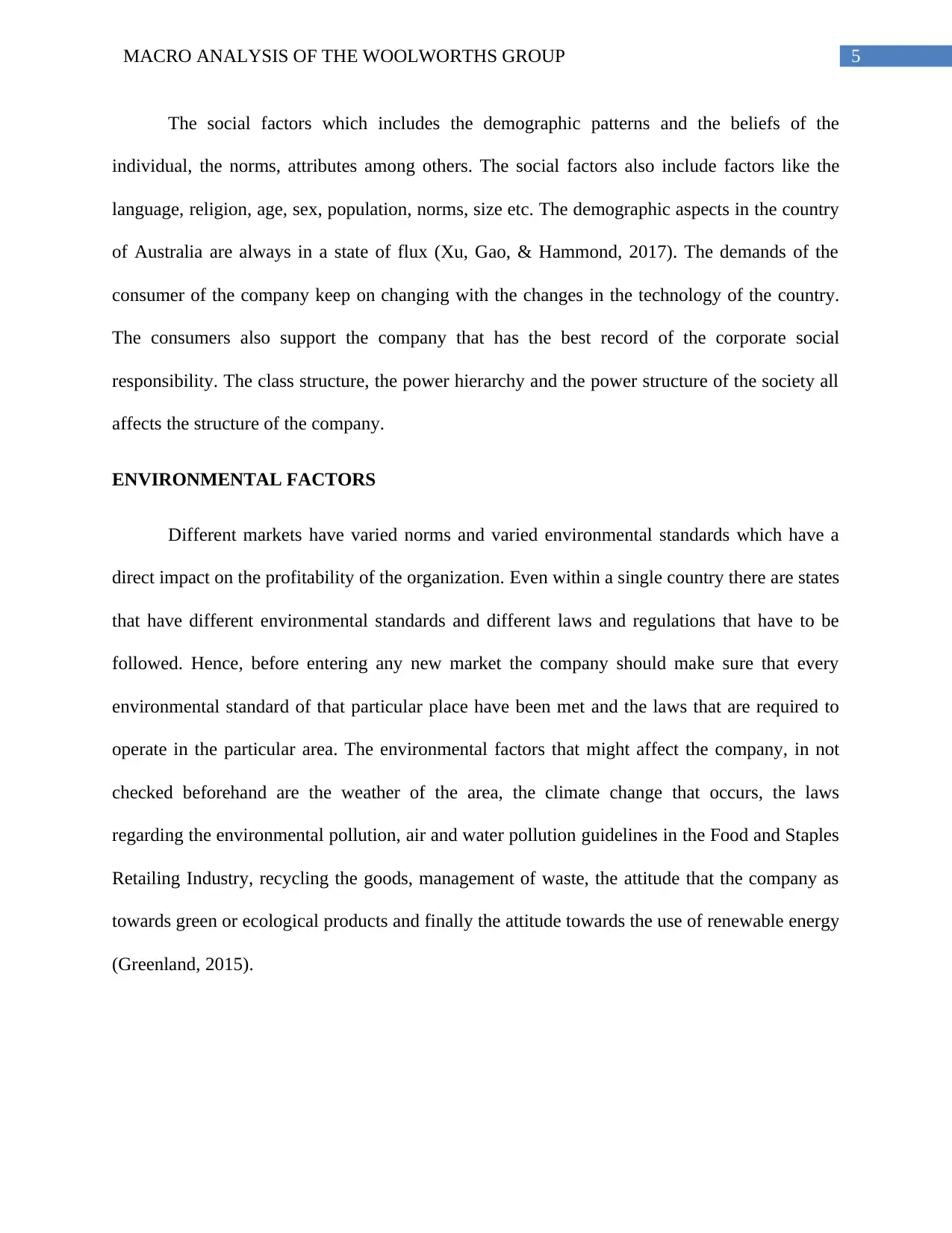
5MACRO ANALYSIS OF THE WOOLWORTHS GROUP
The social factors which includes the demographic patterns and the beliefs of the
individual, the norms, attributes among others. The social factors also include factors like the
language, religion, age, sex, population, norms, size etc. The demographic aspects in the country
of Australia are always in a state of flux (Xu, Gao, & Hammond, 2017). The demands of the
consumer of the company keep on changing with the changes in the technology of the country.
The consumers also support the company that has the best record of the corporate social
responsibility. The class structure, the power hierarchy and the power structure of the society all
affects the structure of the company.
ENVIRONMENTAL FACTORS
Different markets have varied norms and varied environmental standards which have a
direct impact on the profitability of the organization. Even within a single country there are states
that have different environmental standards and different laws and regulations that have to be
followed. Hence, before entering any new market the company should make sure that every
environmental standard of that particular place have been met and the laws that are required to
operate in the particular area. The environmental factors that might affect the company, in not
checked beforehand are the weather of the area, the climate change that occurs, the laws
regarding the environmental pollution, air and water pollution guidelines in the Food and Staples
Retailing Industry, recycling the goods, management of waste, the attitude that the company as
towards green or ecological products and finally the attitude towards the use of renewable energy
(Greenland, 2015).
The social factors which includes the demographic patterns and the beliefs of the
individual, the norms, attributes among others. The social factors also include factors like the
language, religion, age, sex, population, norms, size etc. The demographic aspects in the country
of Australia are always in a state of flux (Xu, Gao, & Hammond, 2017). The demands of the
consumer of the company keep on changing with the changes in the technology of the country.
The consumers also support the company that has the best record of the corporate social
responsibility. The class structure, the power hierarchy and the power structure of the society all
affects the structure of the company.
ENVIRONMENTAL FACTORS
Different markets have varied norms and varied environmental standards which have a
direct impact on the profitability of the organization. Even within a single country there are states
that have different environmental standards and different laws and regulations that have to be
followed. Hence, before entering any new market the company should make sure that every
environmental standard of that particular place have been met and the laws that are required to
operate in the particular area. The environmental factors that might affect the company, in not
checked beforehand are the weather of the area, the climate change that occurs, the laws
regarding the environmental pollution, air and water pollution guidelines in the Food and Staples
Retailing Industry, recycling the goods, management of waste, the attitude that the company as
towards green or ecological products and finally the attitude towards the use of renewable energy
(Greenland, 2015).
⊘ This is a preview!⊘
Do you want full access?
Subscribe today to unlock all pages.

Trusted by 1+ million students worldwide
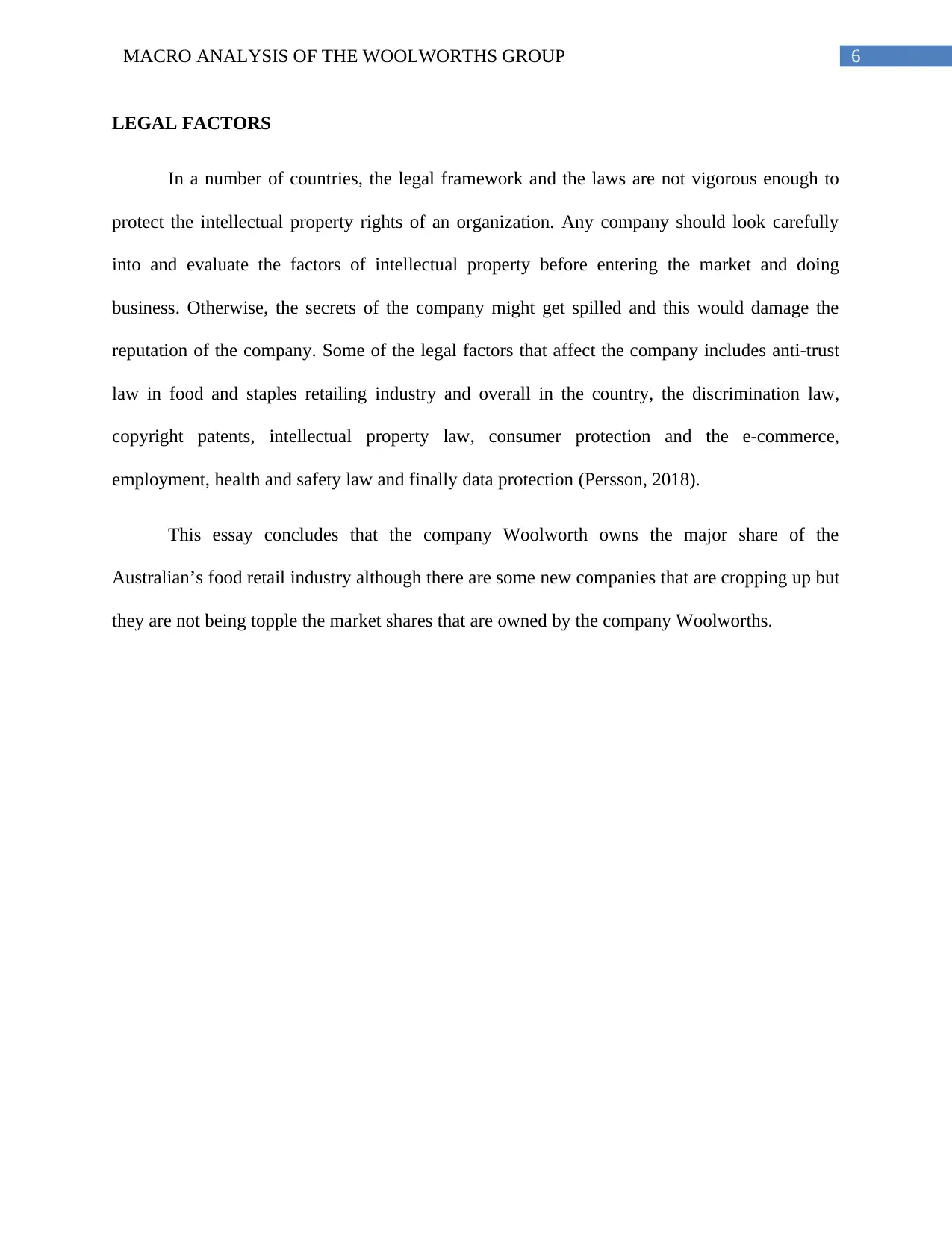
6MACRO ANALYSIS OF THE WOOLWORTHS GROUP
LEGAL FACTORS
In a number of countries, the legal framework and the laws are not vigorous enough to
protect the intellectual property rights of an organization. Any company should look carefully
into and evaluate the factors of intellectual property before entering the market and doing
business. Otherwise, the secrets of the company might get spilled and this would damage the
reputation of the company. Some of the legal factors that affect the company includes anti-trust
law in food and staples retailing industry and overall in the country, the discrimination law,
copyright patents, intellectual property law, consumer protection and the e-commerce,
employment, health and safety law and finally data protection (Persson, 2018).
This essay concludes that the company Woolworth owns the major share of the
Australian’s food retail industry although there are some new companies that are cropping up but
they are not being topple the market shares that are owned by the company Woolworths.
LEGAL FACTORS
In a number of countries, the legal framework and the laws are not vigorous enough to
protect the intellectual property rights of an organization. Any company should look carefully
into and evaluate the factors of intellectual property before entering the market and doing
business. Otherwise, the secrets of the company might get spilled and this would damage the
reputation of the company. Some of the legal factors that affect the company includes anti-trust
law in food and staples retailing industry and overall in the country, the discrimination law,
copyright patents, intellectual property law, consumer protection and the e-commerce,
employment, health and safety law and finally data protection (Persson, 2018).
This essay concludes that the company Woolworth owns the major share of the
Australian’s food retail industry although there are some new companies that are cropping up but
they are not being topple the market shares that are owned by the company Woolworths.
Paraphrase This Document
Need a fresh take? Get an instant paraphrase of this document with our AI Paraphraser
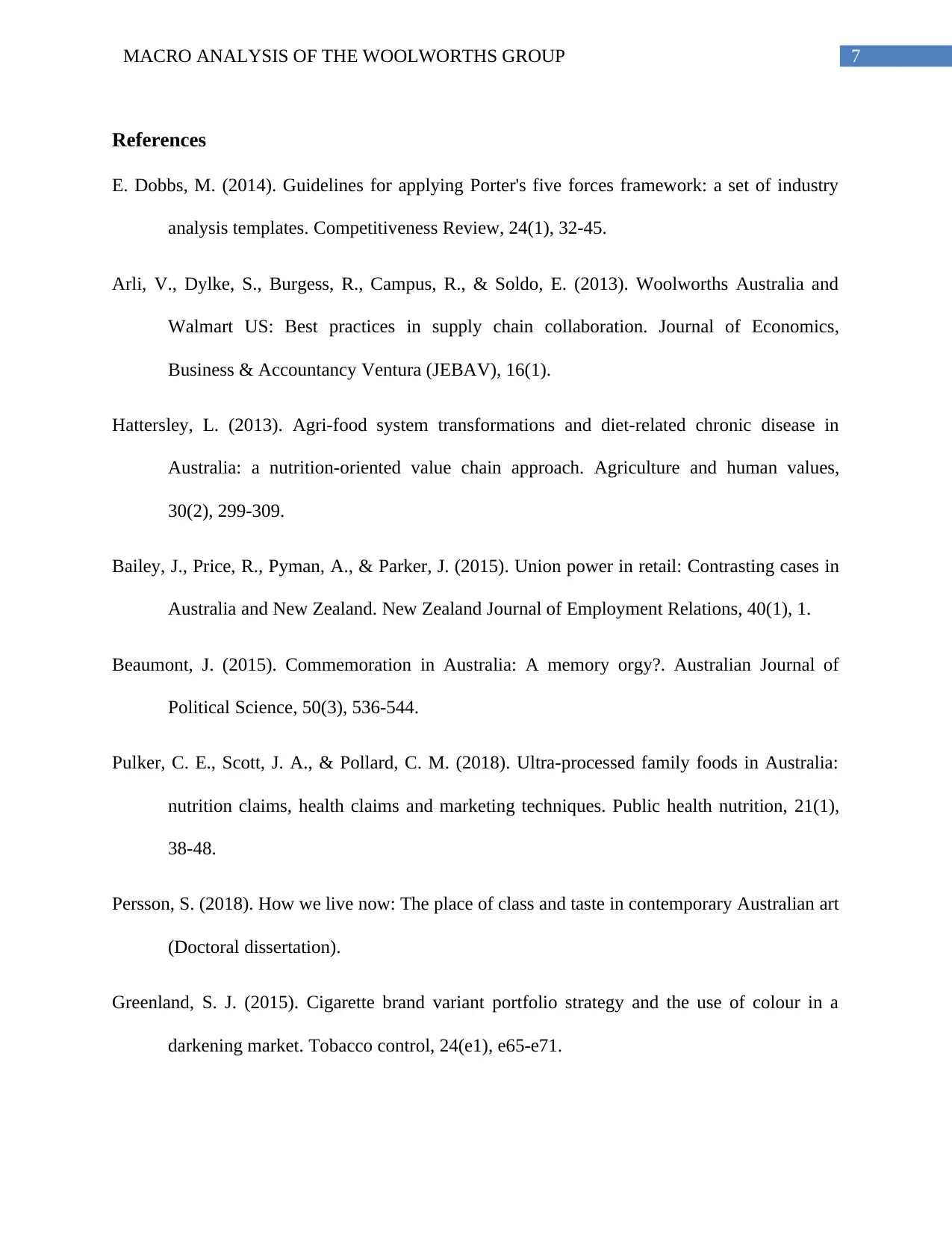
7MACRO ANALYSIS OF THE WOOLWORTHS GROUP
References
E. Dobbs, M. (2014). Guidelines for applying Porter's five forces framework: a set of industry
analysis templates. Competitiveness Review, 24(1), 32-45.
Arli, V., Dylke, S., Burgess, R., Campus, R., & Soldo, E. (2013). Woolworths Australia and
Walmart US: Best practices in supply chain collaboration. Journal of Economics,
Business & Accountancy Ventura (JEBAV), 16(1).
Hattersley, L. (2013). Agri-food system transformations and diet-related chronic disease in
Australia: a nutrition-oriented value chain approach. Agriculture and human values,
30(2), 299-309.
Bailey, J., Price, R., Pyman, A., & Parker, J. (2015). Union power in retail: Contrasting cases in
Australia and New Zealand. New Zealand Journal of Employment Relations, 40(1), 1.
Beaumont, J. (2015). Commemoration in Australia: A memory orgy?. Australian Journal of
Political Science, 50(3), 536-544.
Pulker, C. E., Scott, J. A., & Pollard, C. M. (2018). Ultra-processed family foods in Australia:
nutrition claims, health claims and marketing techniques. Public health nutrition, 21(1),
38-48.
Persson, S. (2018). How we live now: The place of class and taste in contemporary Australian art
(Doctoral dissertation).
Greenland, S. J. (2015). Cigarette brand variant portfolio strategy and the use of colour in a
darkening market. Tobacco control, 24(e1), e65-e71.
References
E. Dobbs, M. (2014). Guidelines for applying Porter's five forces framework: a set of industry
analysis templates. Competitiveness Review, 24(1), 32-45.
Arli, V., Dylke, S., Burgess, R., Campus, R., & Soldo, E. (2013). Woolworths Australia and
Walmart US: Best practices in supply chain collaboration. Journal of Economics,
Business & Accountancy Ventura (JEBAV), 16(1).
Hattersley, L. (2013). Agri-food system transformations and diet-related chronic disease in
Australia: a nutrition-oriented value chain approach. Agriculture and human values,
30(2), 299-309.
Bailey, J., Price, R., Pyman, A., & Parker, J. (2015). Union power in retail: Contrasting cases in
Australia and New Zealand. New Zealand Journal of Employment Relations, 40(1), 1.
Beaumont, J. (2015). Commemoration in Australia: A memory orgy?. Australian Journal of
Political Science, 50(3), 536-544.
Pulker, C. E., Scott, J. A., & Pollard, C. M. (2018). Ultra-processed family foods in Australia:
nutrition claims, health claims and marketing techniques. Public health nutrition, 21(1),
38-48.
Persson, S. (2018). How we live now: The place of class and taste in contemporary Australian art
(Doctoral dissertation).
Greenland, S. J. (2015). Cigarette brand variant portfolio strategy and the use of colour in a
darkening market. Tobacco control, 24(e1), e65-e71.
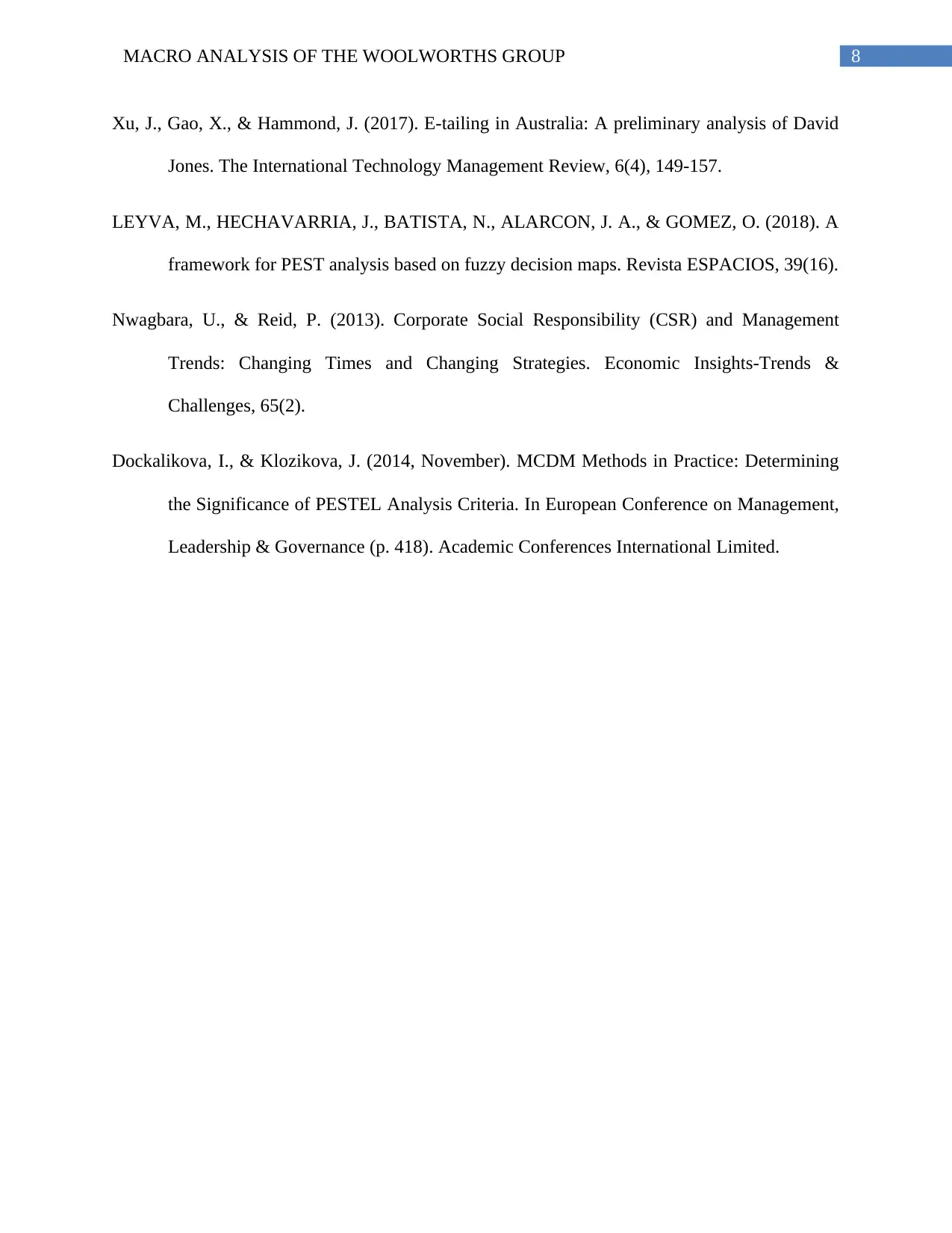
8MACRO ANALYSIS OF THE WOOLWORTHS GROUP
Xu, J., Gao, X., & Hammond, J. (2017). E-tailing in Australia: A preliminary analysis of David
Jones. The International Technology Management Review, 6(4), 149-157.
LEYVA, M., HECHAVARRIA, J., BATISTA, N., ALARCON, J. A., & GOMEZ, O. (2018). A
framework for PEST analysis based on fuzzy decision maps. Revista ESPACIOS, 39(16).
Nwagbara, U., & Reid, P. (2013). Corporate Social Responsibility (CSR) and Management
Trends: Changing Times and Changing Strategies. Economic Insights-Trends &
Challenges, 65(2).
Dockalikova, I., & Klozikova, J. (2014, November). MCDM Methods in Practice: Determining
the Significance of PESTEL Analysis Criteria. In European Conference on Management,
Leadership & Governance (p. 418). Academic Conferences International Limited.
Xu, J., Gao, X., & Hammond, J. (2017). E-tailing in Australia: A preliminary analysis of David
Jones. The International Technology Management Review, 6(4), 149-157.
LEYVA, M., HECHAVARRIA, J., BATISTA, N., ALARCON, J. A., & GOMEZ, O. (2018). A
framework for PEST analysis based on fuzzy decision maps. Revista ESPACIOS, 39(16).
Nwagbara, U., & Reid, P. (2013). Corporate Social Responsibility (CSR) and Management
Trends: Changing Times and Changing Strategies. Economic Insights-Trends &
Challenges, 65(2).
Dockalikova, I., & Klozikova, J. (2014, November). MCDM Methods in Practice: Determining
the Significance of PESTEL Analysis Criteria. In European Conference on Management,
Leadership & Governance (p. 418). Academic Conferences International Limited.
⊘ This is a preview!⊘
Do you want full access?
Subscribe today to unlock all pages.

Trusted by 1+ million students worldwide
1 out of 9
Related Documents
Your All-in-One AI-Powered Toolkit for Academic Success.
+13062052269
info@desklib.com
Available 24*7 on WhatsApp / Email
![[object Object]](/_next/static/media/star-bottom.7253800d.svg)
Unlock your academic potential
Copyright © 2020–2025 A2Z Services. All Rights Reserved. Developed and managed by ZUCOL.





